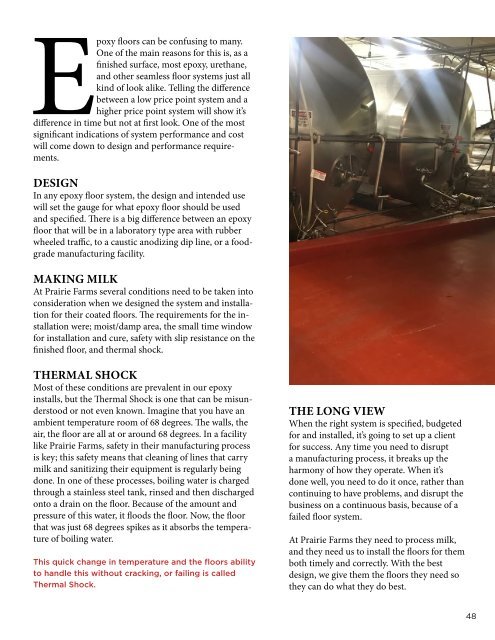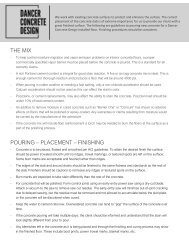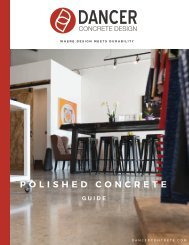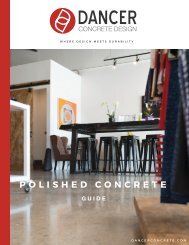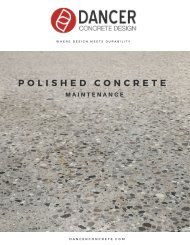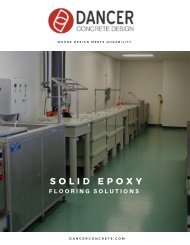2019-The-Process
Create successful ePaper yourself
Turn your PDF publications into a flip-book with our unique Google optimized e-Paper software.
Epoxy floors can be confusing to many.<br />
One of the main reasons for this is, as a<br />
finished surface, most epoxy, urethane,<br />
and other seamless floor systems just all<br />
kind of look alike. Telling the difference<br />
between a low price point system and a<br />
higher price point system will show it’s<br />
difference in time but not at first look. One of the most<br />
significant indications of system performance and cost<br />
will come down to design and performance requirements.<br />
DESIGN<br />
In any epoxy floor system, the design and intended use<br />
will set the gauge for what epoxy floor should be used<br />
and specified. <strong>The</strong>re is a big difference between an epoxy<br />
floor that will be in a laboratory type area with rubber<br />
wheeled traffic, to a caustic anodizing dip line, or a foodgrade<br />
manufacturing facility.<br />
MAKING MILK<br />
At Prairie Farms several conditions need to be taken into<br />
consideration when we designed the system and installation<br />
for their coated floors. <strong>The</strong> requirements for the installation<br />
were; moist/damp area, the small time window<br />
for installation and cure, safety with slip resistance on the<br />
finished floor, and thermal shock.<br />
THERMAL SHOCK<br />
Most of these conditions are prevalent in our epoxy<br />
installs, but the <strong>The</strong>rmal Shock is one that can be misunderstood<br />
or not even known. Imagine that you have an<br />
ambient temperature room of 68 degrees. <strong>The</strong> walls, the<br />
air, the floor are all at or around 68 degrees. In a facility<br />
like Prairie Farms, safety in their manufacturing process<br />
is key; this safety means that cleaning of lines that carry<br />
milk and sanitizing their equipment is regularly being<br />
done. In one of these processes, boiling water is charged<br />
through a stainless steel tank, rinsed and then discharged<br />
onto a drain on the floor. Because of the amount and<br />
pressure of this water, it floods the floor. Now, the floor<br />
that was just 68 degrees spikes as it absorbs the temperature<br />
of boiling water.<br />
This quick change in temperature and the floors ability<br />
to handle this without cracking, or failing is called<br />
<strong>The</strong>rmal Shock.<br />
THE LONG VIEW<br />
When the right system is specified, budgeted<br />
for and installed, it’s going to set up a client<br />
for success. Any time you need to disrupt<br />
a manufacturing process, it breaks up the<br />
harmony of how they operate. When it’s<br />
done well, you need to do it once, rather than<br />
continuing to have problems, and disrupt the<br />
business on a continuous basis, because of a<br />
failed floor system.<br />
At Prairie Farms they need to process milk,<br />
and they need us to install the floors for them<br />
both timely and correctly. With the best<br />
design, we give them the floors they need so<br />
they can do what they do best.<br />
48


